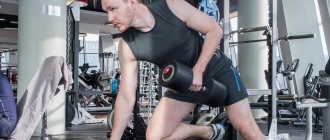There are many opinions regarding the length of each weight training session and the number of weekly workouts, but there is no universal solution among them. Both parameters depend on the conditions in which a person works and on the tasks assigned.
In addition, the drugs used also matter. In particular, anabolic steroids significantly accelerate protein synthesis and increase the body's recovery abilities, which allows you to train longer and more often. Although the effect is not as strong as is commonly believed in non-professional circles.
Thus, the process of hyperplasia of myofibrils (the main functional units of a muscle cell - the more there are, the stronger the cell) when using pharmacological agents is reduced from 10-15 days to 9-10 (source: Bagaudin Bekov “Strength training programs”, 2015, P. 152 ). That is, under ideal conditions (balanced nutrition, intelligently designed microcycle), the rate of true muscle growth may increase by up to 30%, or may not increase. All this is individual.
Naturally, there are still the effects of water retention, an increase in the amount of sarcoplasm in the muscles, active fat gain with disordered eating and other clearly noticeable and rapid reactions of the body, beloved by young “chemists,” but they have nothing to do with the topic of the article and the effective development of the body.
The result of the indiscriminate and unreasonable use of potent drugs, leading to the effects described above, resembles an “accordion” - it swelled up by 10-12 kg in a couple of months, and after stopping the drugs for a month, it all “wasted away”, leaving with a shattered hormonal system and in depressed psychological state.
Thus, I will compare options for the duration of training and their number within a weekly microcycle with specific training programs, goals and a person’s preparedness. This is not the ultimate truth, but many years of experience in studying the topic, working on yourself and with clients.
My opinion may differ from the generally accepted (or established), but it’s up to you to decide whether to try the recommendations below or stay with your opinion and experience. Just don’t forget that if you don’t have noticeable progress in a year or two or three, then it won’t appear out of nowhere. We need to change something, try new things.
How long should I spend in the gym to get pumped up?
The question is obviously incorrect, since the type of physical activity and its intensity are not taken into account.
For example, a tough CrossFitter Workout can knock you down in eight minutes so that even an experienced athlete will not be able to pull himself together all day. In turn, the training of weightlifters and powerlifters, when they work with weights up to 90-95% of the one-repetition maximum, or even reach their peak, can last 2-3 hours or more.
In the first case, there is no rest between exercises, and you actually plow for 8 minutes without a break in a mode that is prohibitive for the body. And in the second case, the athlete squeezed a huge weight a couple of times in a few seconds, after which he rests for 6-8 minutes before the next approach (this is necessary to restore the central nervous system; the energy reserves of the muscles are completely restored in 2.5-3 minutes).
If we talk about fitness and bodybuilding, then a similar dilemma arises regarding the duration of the workout. Especially if you are interested in visible results, and not just spending time in the gym.
How much do local instructors usually advise? 60 minutes no more, and then “terrible catabolism” begins, “muscles are destroyed” and other nonsense.
I don’t argue, sometimes an hour is really enough and we’ll talk about this below. But in reality, the roots of this fable grow from the standard duration of a paid training session with the participation of a trainer. It is the same 60 minutes. And then the fitness instructor has the next client, and you “will begin to go into catabolism if you keep on top of my ears and demand that the banquet be continued.”
You can also turn to history and remember the crazy 3-4 hour workouts of bodybuilders of the golden era.
Arnold Schwarzenegger, in preparation for Olympia, usually trained six days a week for 3-4 hours daily, and sometimes it was a couple of workouts a day with a similar duration each. He looked great.
In turn, Mike Mentzer developed and successfully demonstrated his own “V.I.T.” system. when the duration of one workout did not exceed 45 minutes, there were no more than four or five such workouts per week and each muscle group was loaded no more than once every 6-7 days. And he showed no less impressive form than “Iron Arnie.”
The same system was used by Dorian Yates , a six-time winner of the Mr. Olympia competition.
And where is the truth here? You can, of course, say that such athletes were “charged” with pharmacology to the very eyebrows and there, no matter how you train, you will still grow. But in this regard, I already wrote above that this kind of drugs actually gives. And if everything is so simple, then there would be solid athletic handsome men and beauties walking around. In reality, there are only a few people who truly stand out physically.
This was an introduction and a little theory, now let's look at it from a practical point of view.
Split training.
A large number of people train at random. Without a written training program.
This is the so-called chaotic training. So they come into the hall and wonder, what am I going to do today?
Legs? ... hmm, no)) Breasts? Nope. Arms or abs = yep. Ahaha. )))
Well, do you know what I mean? It is not right.
You must have a developed training program (split program). When going to training, you must clearly know what I will do today.
What determines the duration of training and what it should be?
If you are a beginner , then you obviously start with full-body workouts and first learn the technique of doing the exercises. Usually these are 8-10 exercises, which take about an hour and a half due to the small weight of the burden. This length of training is normal. Gradually the weight of the weights increases, and the workout can last even two hours , which is also ok.
For beginners, the normal mode of work is three strength training sessions per week for the whole body with a rest between them of a day or two and lasting one and a half to two hours each .
Muscles that begin to burn after an hour of intense work are unproven nonsense. They don’t burn and you have more or less enough energy, provided that one and a half to two hours before training you refuel with normal food (proteins + carbohydrates + fiber) or drink at least a good portion of protein 40-60 minutes, if you didn’t have time to do so eat.
Alternatively, if not for fat burning, you can use isotonic drinks with a small amount of glucose, BCAA or energy cocktails made from amino acids (such as ON Essential Amino Energy). They perfectly keep you in good shape during long workouts or especially difficult ones (on leg day, for example).
As for the number of strength training sessions for beginners , the ideal is three per week with a break of a day or two between them. The classic version is Mon-Wed-Fri or Tue-Thu-Sat. Yes, yes, you can easily work in this mode, pumping your entire body three times a week and spending one and a half to two hours on each workout. Moreover, you will also have enough cardio between strength training.
This is personal experience (I arranged several such FullBody cycles for myself) and the experience of the people with whom I worked. It is important here that the training program is designed intelligently and that the load increases very smoothly and carefully.
Simply put, the average duration of a workout of one and a half to two hours is normal and will not harm your body in any way, but will only help you become stronger and more beautiful. Provided that we are talking about the classic mode for 8-12 repetitions with a rest time between sets of 1.5-3 minutes. But there are special cases.
A strength-focused workout can last three hours or more.
For example, training with an emphasis on strength development . This is working with heavy weights up to 90% of the one-rep maximum for 3-6 repetitions. Rest between approaches in this mode can reach 10 minutes, but on average it is at least 5 minutes. And by the time you reach your peak load, you will spend a lot of time warming up with intermediate weights. The duration of such training can reach three hours. This is also normal and natural.
It is unnatural and abnormal to try to cram a strength training session into 60 minutes and try to lift heavy weights without resting the central nervous system and without replenishing the ATP and creatine phosphate stores in the muscles. In this case, you simply will not work 100% and will simply waste your strength training.
By the way, this is precisely the mistake that most people make who want to mindlessly follow popular advice - in this case, the duration of the workout is no more than an hour.
The duration of high-volume training to develop strength endurance and sarcoplasmic hypertrophy does not exceed 60-70 minutes.
The opposite example is high-volume training to develop strength endurance and sarcoplasmic hypertrophy. Its duration usually does not exceed 60-70 minutes, since you simply cannot stand it longer in the mode of 15 repetitions in 2-3 working approaches per exercise and with a rest of no more than 60 seconds between them.
And during training for the production of lactic acid (the so-called acidifying ones), you manage to work out the whole body in 40-50 minutes.
Conclusion
The duration of the training depends on the goals and objectives (true hypertrophy and strength development, sarcoplasmic hypertrophy and endurance development, glycogen burning, acidification, etc.), according to which the type of training is selected. There is no scientific evidence for a 60 minute limit on ANY workout.
You work as long as your body can work, complete the program and move on. In strength mode, you calmly train for 2-3 hours, drinking coffee, isotonic water or amino acids if necessary. In a high-volume mode, there simply isn’t enough strength to function for longer than an hour, and longer is usually not necessary.
What happens if you don’t follow the recommendations?
Your workout will be ineffective. “The incorrect duration of the lesson significantly reduces the effectiveness of the training, to the point of being completely inappropriate,” explains Anastasia Yurkova. - So, for example, if a strength training session lasts longer than an hour, then it will turn into endurance training, other biochemical processes and the necessary process of anabolism (aimed at increasing muscle mass) will turn on, will go into the process of catabolism (that is, destruction) and no increase in you will not get strength indicators. If you train for less than the designated time, then the body simply will not reach the required power by the middle of the workout, and you will not be able to get the desired effect, and the fitness class will turn into a warm-up.”
Follow these recommendations if you want to make your workout effective.
How often do you need to train to get a decent result in the mirror?
Depends on the program and goals. For beginners, as mentioned above, three strength training sessions per week with at least 24 hours of rest between them are effective. But this is just the beginning.
Three strength training sessions per week is the most versatile regimen for most training programs and people.
In principle, this mode works great for other training options, including strength training, sarcoplasmic hypertrophy, or work for maximum fat burning. This is provided that your work schedule or life rhythm does not allow you to train more often.
Although in the case of fat burning, you will have to allocate time for cardio. Moreover, if you want to be stronger, you will also have to work on the treadmill to develop endurance in heavy multi-joint exercises, such as squats with a barbell.
However, if possible, it is better to allocate four workouts per week for strength endurance and sarcoplasmic hypertrophy programs. I gave an example of such a program in this article. It’s the same with fat burning, especially when it comes to a cyclical diet.
In addition, for specialized work on the development of certain muscle groups, a four-day split is also well suited. It allows you to effectively distribute the increased load on certain parts of the body, without forgetting about the rest of the body and without stretching the training over time.
Professional athletes often work out 5-6 times a week (this is only strength work, plus cardio), training a separate muscle group in each workout. It is unlikely that such a regime will suit ordinary people who simply want to get in shape.
On the one hand, this is not effective in the absence of experience and a well-formed neuromuscular connection. On the other hand, it is not a fact that the body will have time to recover without pharmacological support, not to mention the huge expenditure of time.
How long does aerobic training last?
Optimally - from half an hour to an hour. “Cardio training should be done in the range of 30 minutes or longer,” says Anastasia Yurkova. — If your goal is simply daily steady cardio for health, then doing 30 minutes is enough. But, for example, professional athletes of cyclic sports train up to 6-8 hours a day, developing endurance.”
If your goal is fat burning, it makes sense to do cardio for 40 minutes to an hour. However, your heart rate during exercise is important here - check yourself with heart rate zones .
What if you’ve already pumped up and want to maintain the results?
Depends on what the result is. To be sculpted and massive all year round, you will have to work no less on support than to achieve such a shape. But this is usually the lot of actors, athletes and public figures, and not all of them.
If we are talking about a slim, fit and even athletic figure within the limits of reason (which are different for everyone), then, judging by this large-scale study, two strength training sessions per week are enough.
To maintain good physical condition, guys only need two Fullbody strength training sessions per week.
From my own experience, I will say that for lazy support guys, a couple of strength training sessions per week for the whole body is really enough, plus nutrition at the consumption level, provided that it is balanced in nutritional supplements and products (2-2.5 g per kg of body weight, 1 g per kg body weight, 3-4 g per kg body weight respectively, plus the bulk of low GI carbohydrates).
In this regard, it is more difficult for girls, because they gain excess weight much easier and faster than men due to the characteristics of their body.
He is almost always ready to become pregnant, and stores a supply of nutrients for a potential child. For support ladies, I recommend a BEACH-type diet (protein-carbohydrate alternation) and three strength training sessions per week , two of them for the lower body and one for the upper body. But this is a separate, very large topic for conversation both on nutrition and training programs.
How to properly organize your training process?
It all depends on the ultimate goal - losing weight or gaining weight - but in both cases the following tips for organizing training will be relevant:
- Do not visit the hall during rush hour. At this time, queues line up at the exercise machines, which increases the rest time between approaches;
- To burn fat, you need to combine strength and aerobic training, and to gain muscle mass, on the contrary, do it on different days;
- Do not be distracted from the exercises: this negatively affects the execution technique and increases time costs;
- Change your training program periodically. A signal to change the program is a deterioration or suspension of progress;
- Use supersets. They increase the intensity level of the activity;
- Take 1.5 liters of still water with you. This will reduce the time spent on trips to the cooler between approaches.
Why monitor your physical activity?
As mentioned above, movement is life, but it’s worth clarifying exactly how strength training can help your health. Optimal physical activity of a person every day is prevention:
- sudden or early death;
- severe vascular diseases of the heart and brain;
- arterial hypertension;
- diabetes mellitus of various types;
- colon cancer;
- mental illness;
- diseases of the central nervous system;
- osteoporosis (brittle bones).
In addition, as a pleasant bonus for an active person, the following are included:
- improvement of general health;
- good mood;
- toned beautiful body.
Important! Active and regular physical activity improves heart function, trains muscles, stimulates metabolism and prolongs life.
Load level on an exercise bike for weight loss
Exercise is of great importance for losing weight. A workout that takes place at a calm pace will not bring the desired result. You can change the load level in several ways:
- speed change;
- changing the angle of the “road”;
- use of built-in programs - modern models of simulators have several intensity programs to choose from, each of which gives a specific result.
The ideal solution is a combined load, combining, for example, an increase in load and an increase in speed. However, a lot depends on the degree of a person’s preparedness for the load - working “to the limit” throughout the entire workout can cause sprains, which will delay a new lesson indefinitely.
The increase in load should be proportional to the increase in training duration. The first few classes are held at an easy pace - it is important to understand what level of preparation and endurance you have at the moment.
Regular heart rate monitoring will help you understand this. A rapid heartbeat and a feeling of lack of air indicate that the maximum level has now been reached. This may be followed by a significant deterioration in well-being.
The optimal heart rate during training is 120-140 beats per minute. If it is exceeded, you need to reduce the intensity slightly.
Often, deterioration in well-being during training is associated with non-compliance with the drinking regime. Water is a must! Compliance with the drinking regime allows you to more actively remove products of the breakdown of adipose tissue from the body and restore the natural balance of fluid. Much more effective is a special drink for athletes, for example this:
Supersets-trisets-giant-sets
They also help reduce training time. But this technique is only for experienced athletes (beginners and intermediate level categorically cannot use these techniques), I will not describe in more detail..
Because if you are experienced, you already know everything yourself; for beginners, for general development, you can read in the main article: “What is a superset, triset, giant set?”
Exercising on an empty stomach for weight loss
Exercising before meals forces the body to use internal resources as efficiently as possible. When a person is hungry or has just woken up, his body has a fairly low level of glycogen (a reserve reserve of carbohydrates accumulated in the liver and muscles). During training, it is the one that is burned first.
And then the body needs additional energy - and it gets it by starting to break down subcutaneous fat. This is why training “on an empty stomach” is considered the most effective.
What about your diet? How to compose it?
– Here it is important to understand what we mean by “getting your figure in order.” If a person just wants to be thin, he just needs to adjust his diet and add cardio exercise (for example, running). You will lose weight, the percentage of subcutaneous fat layer will decrease. But if we are talking about acquiring sports shape (building muscle mass, increasing strength, etc.), then nutrition alone (like cardio alone) will no longer be enough.
In theory, you can independently create the right diet for yourself, but practice shows that doing this is quite problematic. Of course, if you understand the principles of healthy eating - that the diet should be varied, balanced and should meet your goals (I mean the energy component or calories) - then why not. But for this you need to really bother and spend a lot of time.
I will say that not even all trainers are involved in preparing a diet: not because they don’t know how, but because it is really a very time-consuming process. Therefore, I would recommend contacting a nutritionist or other specialist who can choose a diet for you.
Here are films about nutrition that are worth watching:
- “I want to change” (Hungry for Change), 2012. A film about the secrets of diets and shocking stories of weight loss.
- "Sugar", 2014. An experimental film in which the hero begins to eat exclusively food labeled "healthy" ("good for health") in order to reveal to the audience the bitter truth about sugar, which is actually hidden in freshly squeezed juices, low-fat yoghurts, muesli and other “healthy” foods.
- Forks Over Knives (2011) An American documentary film that promotes lean, whole food, plant-based eating as a way to avoid or reverse some chronic diseases.
Speed on an exercise bike to burn fat
The speed of rotation of the pedals when exercising on an exercise bike is of great importance. After all, it largely depends on it how many calories will be burned. Here is an approximate calculation of the ratio:
| Speed (km/h) | Number of calories burned |
| 15-17 | 340-360 |
| 18-20 (Medium pace) | 400-420 |
| 21-25 | 480-500 |
| 26-30 | 580-600 |
| Over 30 | 650-670 |
Additional load (some models of simulators allow you to change the degree of incline, increasing the difficulty) help increase the number of calories burned. The same applies to the time of the lesson - the longer you study, the more energy you will spend. Calculate your burned calories using our calculator.











